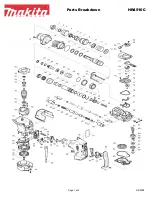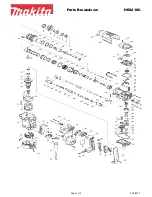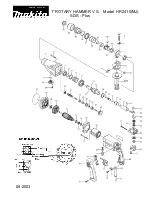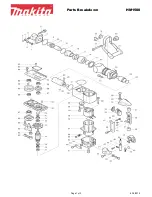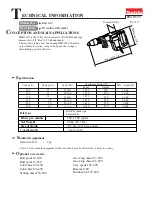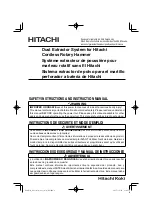
16
17
• Wear ear protectors.
Exposure to noise can
cause hearing loss.
• Use auxiliary handle(s), if supplied with the
tool.
Loss of control can cause personal injury.
• Hold power tools by insulated gripping sur-
faces, when performing an operation where the
cutting tool may contact hidden wiring or its
own cord.
Cutting accessory contacting a “live” wire
may make exposed metal parts of the power tool
“live” and could give the operator an electric shock.
• Keep hands away from all cutting edges and
moving parts.
• Maintain labels and nameplates.
These carry
important information. If unreadable or missing,
contact a
MILWAUKEE
service facility for a free
replacement.
• WARNING:
Some dust created by power sanding,
sawing, grinding, drilling, and other construction
activities contains chemicals known to cause can-
cer, birth defects or other reproductive harm. Some
examples of these chemicals are:
• lead from lead-based paint
• crystalline silica from bricks and cement and other
masonry products, and
• arsenic and chromium from chemically-treated
lumber.
Your risk from these exposures varies, depending
on how often you do this type of work. To reduce
your exposure to these chemicals: work in a well
ventilated area, and work with approved safety
equipment, such as those dust masks that are spe-
cifi cally designed to fi lter out microscopic particles.
SPECIFIC SAFETY RULES
SYMBOLOGY
Double Insulated
Volts Alternating Current
W
Watts
No Load Strokes per Minute
(SPM)
Seal of Electrical Security
Read operator's manual
Wear hearing protection
Wear eye protection
SPECIFICATIONS
Tool
Capacities
Cat. No.
Volts
AC
W
No
Load
RPM
No
Load
BPM
Rotary Hammer (concrete)
Drill Only
Carbide Tipped
Percussion Bit
Thin Wall
Percussion
Core Bits
Twist
Drill Bit
(Wood)
Twist
Drill Bit
(Steel)
5262-59
5262-59A
5262-59B
220-240V 50-60 Hz
220-240V 50-60 Hz
127V 50-60 Hz
800
800
800
0-1 500
0-1 500
0-1 500
0-5 625
0-5 625
0-5 625
7/8"
2-1/8"
1-1/8"
1/2"
1. Side handle
2. Clamp
3. Depth gauge rod
4. SDS Plus bit holder
5. Mode selector lever
6. Trigger
7. Forward/Reverse control switch
2
1
3
5
4
6
7
FUNCTIONAL DESCRIPTION
Fig. B Fig. C
Fig. A
WARNING
To reduce the risk of injury,
always use a side handle when using
this tool. Always brace or hold securely.
ASSEMBLY
WARNING
To reduce the risk of injury,
always unplug tool before attaching
or removing accessories or making adjust-
ments. Use only specifi cally recommended
accessories. Others may be hazardous.
Adjusting the Side Handle Position
1. Loosen the side handle by unscrewing the side
handle grip until the side handle rotates freely.
2. Rotate the side handle to the desired position.
3. Tighten the side handle grip securely.
WARNING
To reduce the risk of injury
do not grasp the bit while the chuck is
rotating or while the bit is falling from the
chuck.
GROUNDING
WARNING
Improperly connecting the
grounding wire can result in the risk of
electric shock. Check with a qualifi ed electri-
cian if you are in doubt as to whether the
outlet is properly grounded. Do not modify
the plug provided with the tool. Never remove
the grounding prong from the plug. Do not
use the tool if the cord or plug is damaged. If
damaged, have it repaired by a MILWAUKEE
service facility before use. If the plug will not
fi t the outlet, have a proper outlet installed by
a qualifi ed electrician.
Grounded Tools: Tools with Three Prong Plugs
Tools marked “Grounding Required” have a three
wire cord and three prong grounding plug. The
plug must be connected to a properly grounded
outlet (See Figure A). If the tool should electrically
malfunction or break down, grounding provides a
low resistance path to carry electricity away from
the user, reducing the risk of electric shock.
The grounding prong in the plug is connected
through the green wire inside the cord to the
grounding system in the tool. The green wire in the
cord must be the only wire connected to the tool's
grounding system and must never be attached to
an electrically “live” terminal. Your tool must
be plugged into an appropriate outlet, prop-
erly installed and grounded in accordance
with all codes and ordinances. The
plug and outlet should look like
those in Figure A.
Double Insulated Tools: Tools
with Two Prong Plugs
Tools marked “Double Insulated” do not require
grounding. They have a special double insulation
system which satisfi es OSHA requirements and
complies with the applicable standards of Underwrit-
ers Laboratories, Inc., the Cana-
dian Standard Association and the
National Electrical Code. Double
Insulated tools may be used in ei-
ther of the 120 volt outlets shown in
Figures B and C.
Grounded tools require a three wire extension
cord. Double insulated tools can use either a two
or three wire extension cord. As the distance from
the supply outlet increases, you must use a heavier
gauge extension cord. Using extension cords with
inadequately sized wire causes a serious drop in
voltage, resulting in loss of power and possible tool
damage. Refer to the table shown to determine the
required minimum wire size.
The smaller the gauge number of the wire, the
greater the capacity of the cord. For example, a 14
gauge cord can carry a higher current than a 16
gauge cord. When using more than one extension
cord to make up the total length, be sure each cord
contains at least the minimum wire size required.
If you are using one extension cord for more than
one tool, add the nameplate amperes and use the
sum to determine the required minimum wire size.
Guidelines for Using Extension Cords
• If you are using an extension cord outdoors, be
sure it is marked with the suffi x “W-A” (“W” in Cana-
da) to indicate that it is acceptable for outdoor use.
• Be sure your extension cord is properly wired
and in good electrical condition. Always replace
a damaged extension cord or have it repaired by
a qualifi ed person before using it.
• Protect your extension cords from sharp objects,
excessive heat and damp or wet areas.
READ AND SAVE ALL
INSTRUCTIONS FOR FUTURE USE.
Recommended Minimum Wire Gauge
for Extension Cords*
Extension Cord Length
* Based on limiting the line voltage drop to fi ve volts
at 150% of the rated amperes.
Nameplate
Amperes
0 - 2.0
2.1 - 3.4
3.5 - 5.0
5.1 - 7.0
7.1 - 12.0
12.1 - 16.0
16.1 - 20.0
25'
18
18
18
18
16
14
12
75'
18
18
16
14
12
10
100'
18
16
14
12
10
150'
16
14
12
12
50'
18
18
18
16
14
12
10
EXTENSION CORDS
Setting the Depth Gauge
1. Press in the clamping lever.
2. Slide the depth gauge rod backward or forward
until it is set for the desired depth.
NOTE:
The drilling depth is the distance between
the tip of the bit and the tip of the rod.
3. Release the clamping lever.












